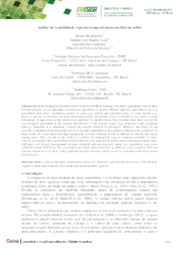Análise da variabilidade espectro-temporal intraespecífica do milho.
Análise da variabilidade espectro-temporal intraespecífica do milho.
Autoria: MONTIBELLER, B.; LUIZ, A. J. B.; SANCHES, I. D. A.; SILVEIRA, H. L. F. da
Resumo: Remote sensing data has been widely used worldwide to estimate crop field?s parameters such as area. For that purpose, we use automatic classification algorithms to identify different land uses and land covers (e.g. agricultural and native vegetation), groups of crops (e.g. annual and perennial crops) or crops species (e.g. maize, sugarcane or soybean). For agricultural applications, the ultimate goal is to be able to use remote sensing technology to map crops in the specie level, and then to monitor them. One essential input data used in the classifications algorithms is the spectral information of the ground targets (e.g. reflectance and vegetation indices). Therefore, it is important to know the spectral behavior of all targets. However, the ability of one classifier to distinguish between plant species is probably dependent on the amount of intraspecific variability. In other words, if a crop specie has high intraspecific spectral variation, it will be difficult to classify this specie among others. Thus, the aim of this work is to analyze the intraspecific spectral temporal variability of maize crop. To accomplish that, spectral data (OLI/Landsat-8) were acquired from first and second harvest maize plots, cultivated over distinct management systems (irrigated and non-irrigated), along two agricultural crop years, (2014/2015 and 2015/2016). We concluded that maize fields harvested in different years, sowed in different seasons, irrigated or not, have a high temporal spectral variation, which cannot be associated with these known characteristics.
Ano de publicação: 2017
Tipo de publicação: Artigo em anais e proceedings
Unidade: Embrapa Meio Ambiente
Observações
1 - Por padrão são exibidas publicações dos últimos 20 anos. Para encontrar publicações mais antigas, configure o filtro ano de publicação, colocando o ano a partir do qual você deseja encontrar publicações. O filtro está na coluna da esquerda na busca acima.
2 - Para ler algumas publicações da Embrapa (apenas as que estão em formato ePub), é necessário ter, no celular ou computador, um desses softwares gratuitos. Sistemas Android: Google Play Livros; IOS: iBooks; Windows e Linux: software Calibre.
Acesse outras publicações
Acesse a Base de Dados da Pesquisa Agropecuária (BDPA) para consultar o acervo completo das bibliotecas da Embrapa.

